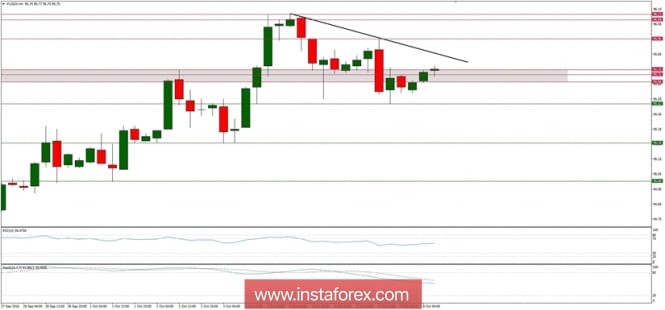The week starts with the low volatility of the currency market. EUR/USD is at 1.1515, in the area recorded before the Friday publication of the US labor market report. USD/JPY is also exactly at the same level, 113.85. After a long break, investors have returned to Chinese exchanges and the start of the week brings painful discounts in Shanghai and Shenzhen. On commodity markets, a continuation of oil price drops started on Thursday and re-dip of gold at USD 1,200 per ounce. The pound is the strongest currency gaining on the wave of optimism which again dominates the discussions around Brexit negotiations. At the other extreme is NZD/USD which descent at 0.6440 should be associated with the collapse of the put option of a large value on Friday (and shallow market). At the Monday's session, oil-related currencies, namely NOK and CAD, are under moderate pressure.
The People's Bank of China cut the mandatory reserve for most banks by 100 bp. The releasing will take effect on October 15 and will increase liquidity in the sector by the equivalent of 0.7% of the deposit value. The movement demonstrates PBoC's determination to support sentiment and prosperity with the use of conventional tools, but it may turn out that in the face of trade wars more and more radical measures will be needed.
Friday on Wall Street ended with a discount on major stock exchanges which is continuing in the listing in Hong Kong. After the festive break, the indexes in Shanghai and Shenzen fell, in the first case by almost 3 percent. USA 10Y debt yield at the end of Friday was 3.23%.
On commodity markets, it is worth paying attention to the 0.6-percent drop in gold prices and the 1-percent silver discount. An ounce of ore is again valued at less than USD 1,200. The WTI oil price is falling by almost 1 percent, under 73.75. This means breaking the Thursday minimum and drawing a third of the next black candle on the chart.
DXY analysis for 08/10/2018:
For emerging markets, for the BOVESPA index, but also coffee and sugar, the results of the first round of the presidential election in Brazil are an important solution. A former army officer, representing the extreme right, J. Bolsonaro obtained over 46% of votes and was close to resolving the elections in the first round. In the second round, planned for 28.10, he will face F. Haddad, who is starting from the Labor Party. Of the two main candidates, Bolsonaro gives more hope for reform (or rather is a smaller threat to public finances). The increase in support for him last week was a contribution to the rally of Brazilian assets, real, coffee and sugar, but such a crushing lead is not seen in the prices.
Let's now take a look at the US Dollar Index technical picture at the H4 time frame. The market has bounced from the support at the level of 95.22 and currently is hovering around the old technical resistance at 95.75. The price is still below the short-term trend line resistance. The next target for bulls is seen at the level of 95.95 and if this level is violated, then the bulls might test the swing high at the level of 96.12. Please notice the positive but not that strong RSI indicator supporting the bullish outlook.

